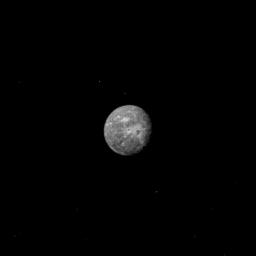
|
Uranus’ Largest Moon Oberon
- Click the image above for a larger view
- Full-Res JPEG (1500 x 1500) (33.1 kB)
- Full-Res TIFF (1500 x 1500) (60.7 kB)
Caption:
Uranus' outermost and largest moon, Oberon, is seen in this Voyager 2 image, obtained Jan. 22, 1986, from a distance of 2.77 million kilometers (1.72 million miles). The clear-filter image, shuttered by Voyager's narrow-angle camera, shows that Oberon displays several distinct highly reflective (high-albedo) patches with low-albedo centers. Some of the bright patches are suggestive of radial patterns that could represent impact craters excavated from an icy surface. On average, Oberon reflects about 20 percent of the incident sunlight. The moon is about 1,600 km (1,000 mi) in diameter; resolution of this image is 51 km (32 mi). It was taken two days before Voyager's closest approach to Oberon, at which point the spacecraft will be about 471,000 km (293,000 mi) away.
Background Info:
The Voyager project is managed for NASA by the Jet Propulsion Laboratory.
Cataloging Keywords:
| Name | Value | Additional Values |
|---|---|---|
| Target | Oberon | |
| System | Uranus | |
| Target Type | Satellite | |
| Mission | Voyager | |
| Instrument Host | Cassini Orbiter | Voyager 2 |
| Host Type | Orbiter | Flyby Spacecraft |
| Instrument | Imaging Science Subsystem (ISS) | |
| Detector | Narrow Angle Camera | |
| Extra Keywords | Crater, Grayscale, Impact, Visual | |
| Acquisition Date | ||
| Release Date | 1998-10-13 | |
| Date in Caption | 1986-01-22 | |
| Image Credit | NASA/JPL | |
| Source | photojournal.jpl.nasa.gov/catalog/PIA01352 | |
| Identifier | PIA01352 | |
